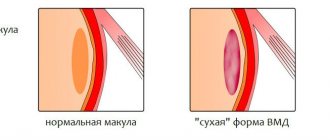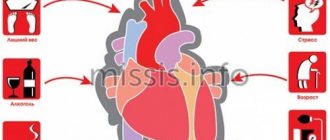Myocardial dystrophy is a complex pathological process in cells (cardiomyocytes), leading to depletion of energy reserves. At the same time, the ability to recover is not lost for a long time.
Changes occur at the level of cell metabolism. Failure of the energy synthesis process disrupts myocardial contractility. It is extremely difficult to identify clear manifestations at the initial stage. Myocardial dystrophy has been most studied in diseases accompanied by changes in metabolism (thyrotoxicosis, hypothyroidism, severe anemia, poison intoxication, vitamin deficiency).
Heart defects and myocarditis cause a combination of inflammation and degenerative changes in the myocardium. It is quite difficult to find out which of these processes prevails - inflammatory or dystrophic.
Myocardial dystrophy as a consequence of physical overexertion
Myocardial dystrophy can be a secondary disease that manifests itself against the background of other heart diseases that are not fully cured.
But often the heart muscle weakens due to too intense stress on the body. Excessive exercise is not beneficial, as organs begin to work at an accelerated rate and quickly wear out. Each person has his own body and his own physical capabilities, which allow him to perform some kind of work, do complex exercises and win competitions. Negative changes in the work of the heart occur not just from constant sports training, but precisely from the discrepancy between the loads and the individual capabilities of the body. If these possibilities and their limits are not taken into account, very soon the heart and other organs will begin to suffer serious failures. Regardless of what factors provoke the development of myocardial dystrophy, you need to take into account your personal characteristics and know the limit of physical stress that should not be crossed. For example, the same changes in the work of the heart muscle will occur in a trained athlete who runs a marathon at speed and in an ordinary person who is not keen on sports, who had to catch up with a leaving minibus at a pace that is unusual for his body. This suggests that every person should sensibly assess the capabilities of their muscles, respiratory system and heart, so as not to create unbearable working conditions for themselves or get carried away with overly complex and long workouts.
There are two types of heart strain: acute and chronic. Acute is the most dangerous, as it sometimes entails irreversible changes and complications that, if you are not attentive to your condition, can lead to death. These are hemorrhages in the heart, myocardial dystrophy or even a heart attack. If this type manifests itself in a mild form, then it is possible to immediately notice and stop any stress on the heart until it returns to normal. Heart pain manifests itself, and serious changes will be observed during an ECG check. A person may suffer from shortness of breath during any exertion, which was not the case before, and may also experience disturbances in the rhythm of the heartbeat.
If we talk about the chronic form, then most often this is actually myocardial dystrophy. It often manifests itself in fully trained athletes who have not been cured of some infectious disease that causes complications on the heart. These are tonsillitis, cholecystitis, caries, which is usually chronic. At the very beginning of the manifestation of dystrophy, sports fans do not feel any health problems and therefore do not change their lifestyle, continuing to train at the same rhythm. This is the danger of the disease, that it is difficult to identify it in the initial stages without undergoing appropriate checks and studies of the body.
Causes
Changes in the functioning of the heart occur for several reasons related to sports activities. This:
- Frequent stress on the body due to training and preparation for serious competitions. Usually people, wanting to win, do not spare themselves and their bodies by exercising too much time. If we take into account not very good nutrition and lack of sleep and rest, then everything goes to the point that sooner or later the heart will begin to “protest” against this way of life. To prevent this, you should not torture yourself before the competition, exhausting yourself with back-breaking exercises without proper rest. Still, health is more important and should always come first. The healthiest and most resilient win, so it makes sense to take care of yourself before a serious event.
- Intense sports activities in physically unprepared people. If the body has not previously received such loads, then immediately excessive training can seriously damage the heart, since it will not cope with such rapid changes. The same applies when a person changes his sport and immediately begins to actively train in something in which he is still weak. To prevent overload on the heart, any vigorous activity should be started gradually, increasing the intensity.
- A combination of intense sports with strenuous work or other intellectual activities. A direct blow to the physical and mental areas of the human body can lead to malfunctions and even an emotional breakdown. The same applies to playing sports immediately after an infectious disease, such as tonsillitis, flu, etc.
Symptoms
You need to know the signs of myocardial dystrophy so that you can promptly seek medical help and begin treatment as soon as possible. The symptoms of the disease are:
- Shortness of breath and fatigue. This can manifest itself during severe stress that a person received constantly. The strange “behavior” of the body should alert you. You should never continue training if your heart is not behaving as usual. Shortness of breath can be bothersome even when walking or climbing stairs.
- Rapid or strong heartbeat. If earlier sports training did not cause any inconvenience, now the heart will actively react to any, even the smallest load. Strong muscle contraction is evidence of improper functioning of the organ.
- Dizziness, nausea and vomiting. All symptoms are similar to those of poisoning, even if the patient eats exclusively healthy food. These signs may indicate that the heart is not functioning properly.
- Muscle pain and weakness, which manifests itself constantly, even without much stress on the body.
- Loss of consciousness.
- Acute pain in the heart. It may indicate that myocardial dystrophy has acquired complications and leads to a heart attack. In this case, the pressure can drop sharply, and the person begins to suffocate from lack of oxygen. Sometimes you can observe a strong cardiac cough and wheezing in the chest area.
If such symptoms occur, the person should immediately stop any exercise and maintain maximum rest to allow the heart to recover. If pain occurs, it is important to immediately consult a doctor or call an ambulance, as this is an extremely serious situation. For several weeks you need to limit yourself to any sport and not participate in any competitions. The doctor can determine whether it is acceptable for the patient to start playing his favorite sport.
Clinical manifestations
Symptoms of myocardial dystrophy are not typical for one disease.
Most often, metabolic changes are manifested by arrhythmias: from extrasystole to atrial fibrillation. After all, foci of altered cells block the normal paths of impulse propagation. The person feels an interruption in rhythm.
Pain in the heart area does not have a typical characteristic: stabbing, dull and aching, and is not necessarily related to physical activity.
Over time, signs of heart failure appear:
- dyspnea,
- increased fatigue,
- tachycardia,
- swelling on the feet.
Treatment and prevention
If myocardial dystrophy has developed due to an untreated infection, then you need to make every effort to get rid of all foci of side diseases.
The underlying problem needs to be treated, and then the heart will get relief. If the disease is mild, you can be treated at home, only by seeing a cardiologist on time, who will adjust the therapy and give useful advice regarding lifestyle. The selection of medications, various procedures and measures will depend on the cause of myocardial dystrophy. If the root cause of the disease is serious overstrain of the body, muscle overload, then a competent doctor will prohibit any activities for a while to allow the heart to recover. And then he will adjust his training regimen to prevent a relapse. If dystrophy has arisen due to constant stress, emotional instability, the doctor will prescribe something soothing and offer to get rid of problematic situations as much as possible: change jobs, move to another place, stop communicating with negative people, watch depressing news, etc.
In any case, you need to spare your body, ensure good rest, which will bring joy and positive emotions. Surround yourself with friendly people and go for walks as often as possible, since you shouldn’t completely give up physical activity. If anemia occurs, you should start feeding your body the necessary vitamins that contain iron. For endocrine disorders, it is suggested to use hormones to restore the correct balance of all elements. Treatment of myocardial dystrophy will be individual in each case, so you should not start independent therapy without knowing the true cause of the disease. All treatment methods must be agreed upon with a doctor, who will first send you for examination in order to draw the right conclusions regarding the patient’s health.
It is much easier to prevent a disease than to treat it later. It is worth using all preventive methods that will protect the heart from disease. To do this, you need to train moderately and avoid even the slightest overload on the body. There must be proper nutrition, which will nourish the cells with the necessary substances, and the blood vessels will be in good shape.
Why does dystrophy occur?
There are 2 groups of reasons:
- heart disease that promotes metabolic disorders in cells (ischemic heart disease, myocarditis, cardiomyopathies); impaired coronary patency, inflammation and accumulation of waste in the tissue are important in the pathogenesis;
- extracardiac - through nervous regulation, disruption of hormone synthesis, disruption of the composition of blood cells affect the biochemical processes in the myocardium.
The second group of reasons include:
- consequences of chronic tonsillitis;
- poisoning with industrial and household poisons;
- decrease in the level of red blood cells in anemia of various etiologies and blood diseases;
- toxic side effects of medications (antibiotics, hormonal agents, cytostatics);
- endocrine pathology, especially of the adrenal glands and thyroid gland;
- lack of vitamins C (for scurvy) and B1 (for polyneuritis, alcoholism, enterocolitis);
- chronic kidney disease;
- long-term chronic respiratory diseases.
Dystrophy in athletes is caused by excessive physical activity and stress. Young people's passion for bodybuilding and all sorts of ways to pump up muscles leads to the early development of myocardial dystrophy.
Permissible physical activity for myocardial dystrophy
Myocardial dystrophy requires partial rest so as not to overload the heart muscle.
After all, this can lead to serious complications and even death. But no one says that you need to give up sports completely. To treat the heart muscle, special physical therapy is provided, which allows you to develop the organ and thereby quickly treat it from the disease. At the same time, the “dosage” of such physical education should be prescribed on a strictly individual basis, since what is suitable for one person can be dangerous or even fatal for another. They use gymnastic exercises that exclude strength exercises, so as not to strain the heart. In addition to gymnastics, it is recommended to walk every day and gradually increase the walking time. The duration of gymnastics should not be more than half an hour, since patients need rest. The exercises used are those aimed at intense movements of the limbs. Breathing exercises are required to develop and train the diaphragm. All exercises must be done so that the load on parts of the body is distributed evenly.
In addition to therapeutic exercises, you can go on walking excursions, play volleyball, but no more than half an hour. Bathing and swimming will also be useful, but in moderate doses. In winter it is permissible to skate and ski. With myocardial dystrophy, it is advisable to spend the day actively, alternating physical activity with rest. One-time intense workouts that put the heart at risk by forcing it to work at full capacity should be avoided. Moderate body training will be beneficial if the disease has not taken an acute form, which requires only rest with limited movement.
Diagnostics
The most common method of examining patients is electrocardiography, which provides sufficient information for the initial manifestations of cardiac dystrophy.
- The doctor at the functional diagnostics office determines metabolic changes, conduction disorders (blockades) and rhythm by the nature of the teeth when deciphering.
- During auscultation, one can indirectly suspect the onset of pathology by dull heart sounds.
- Histological studies are carried out in a living person extremely rarely. It is possible to take material for a biopsy for differential diagnosis with a tumor.
- Magnetic resonance imaging shows the degree of energy deficiency of the heart muscle.
Unlike acute myocardial infarction, biochemical blood samples do not show signs of tissue breakdown (transaminases, creatine phosphokinase, lactate dehydrogenase) and leukocytosis.
Only under a microscope can you see what fatty degeneration of the myocardium looks like








